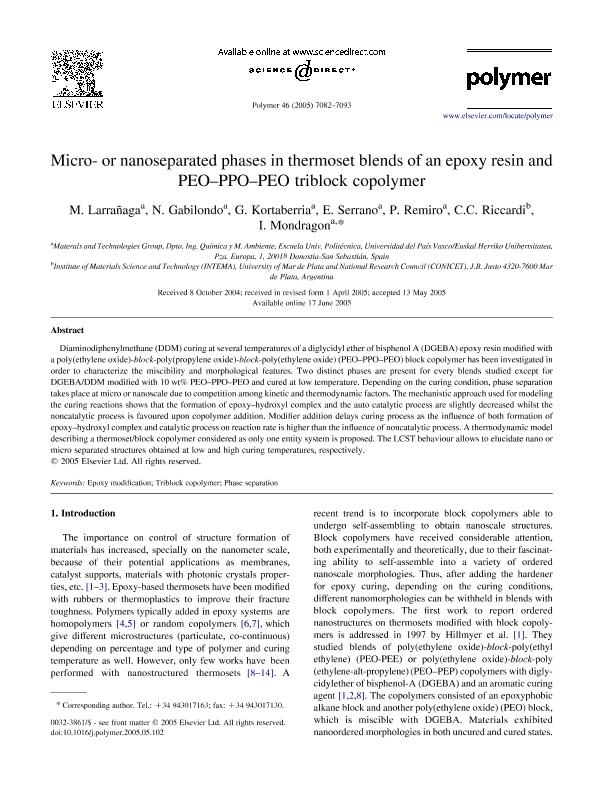Mostrar el registro sencillo del ítem
dc.contributor.author
Larrañaga, M.
dc.contributor.author
Gabilondo, N.
dc.contributor.author
Kortaberria, G.
dc.contributor.author
Serrano, E.
dc.contributor.author
Remiro, P.
dc.contributor.author
Riccardi, Carmen Cristina

dc.contributor.author
Mondragon, I.
dc.date.available
2020-01-13T14:17:49Z
dc.date.issued
2005-08
dc.identifier.citation
Larrañaga, M.; Gabilondo, N.; Kortaberria, G.; Serrano, E.; Remiro, P.; et al.; Micro- or nanoseparated phases in thermoset blends of an epoxy resin and PEO–PPO–PEO triblock copolymer; Elsevier; Polymer; 46; 18; 8-2005; 7082-7093
dc.identifier.issn
0032-3861
dc.identifier.uri
http://hdl.handle.net/11336/94482
dc.description.abstract
Diaminodiphenylmethane (DDM) curing at several temperatures of a diglycidyl ether of bisphenol A (DGEBA) epoxy resin modified with a poly(ethylene oxide)-block-poly(propylene oxide)-block-poly(ethylene oxide) (PEO–PPO–PEO) block copolymer has been investigated in order to characterize the miscibility and morphological features. Two distinct phases are present for every blends studied except for DGEBA/DDM modified with 10 wt% PEO–PPO–PEO and cured at low temperature. Depending on the curing condition, phase separation takes place at micro or nanoscale due to competition among kinetic and thermodynamic factors. The mechanistic approach used for modeling the curing reactions shows that the formation of epoxy–hydroxyl complex and the auto catalytic process are slightly decreased whilst the noncatalytic process is favoured upon copolymer addition. Modifier addition delays curing process as the influence of both formation of epoxy–hydroxyl complex and catalytic process on reaction rate is higher than the influence of noncatalytic process. A thermodynamic model describing a thermoset/block copolymer considered as only one entity system is proposed. The LCST behaviour allows to elucidate nano or micro separated structures obtained at low and high curing temperatures, respectively.
dc.format
application/pdf
dc.language.iso
eng
dc.publisher
Elsevier

dc.rights
info:eu-repo/semantics/openAccess
dc.rights.uri
https://creativecommons.org/licenses/by-nc-sa/2.5/ar/
dc.subject
EPOXY MODIFICATION
dc.subject
TRIBLOCK COPOLYMER
dc.subject
PHASE SEPARATION
dc.subject.classification
Ingeniería Química

dc.subject.classification
Ingeniería Química

dc.subject.classification
INGENIERÍAS Y TECNOLOGÍAS

dc.title
Micro- or nanoseparated phases in thermoset blends of an epoxy resin and PEO–PPO–PEO triblock copolymer
dc.type
info:eu-repo/semantics/article
dc.type
info:ar-repo/semantics/artículo
dc.type
info:eu-repo/semantics/publishedVersion
dc.date.updated
2019-11-25T17:31:19Z
dc.journal.volume
46
dc.journal.number
18
dc.journal.pagination
7082-7093
dc.journal.pais
Países Bajos

dc.journal.ciudad
Amsterdam
dc.description.fil
Fil: Larrañaga, M.. Universidad del País Vasco; España
dc.description.fil
Fil: Gabilondo, N.. Universidad del País Vasco; España
dc.description.fil
Fil: Kortaberria, G.. Universidad del País Vasco; España
dc.description.fil
Fil: Serrano, E.. Universidad del País Vasco; España
dc.description.fil
Fil: Remiro, P.. Universidad del País Vasco; España
dc.description.fil
Fil: Riccardi, Carmen Cristina. Consejo Nacional de Investigaciones Científicas y Técnicas. Centro Científico Tecnológico Conicet - Mar del Plata. Instituto de Investigaciones en Ciencia y Tecnología de Materiales. Universidad Nacional de Mar del Plata. Facultad de Ingeniería. Instituto de Investigaciones en Ciencia y Tecnología de Materiales; Argentina
dc.description.fil
Fil: Mondragon, I.. Universidad del País Vasco; España
dc.journal.title
Polymer

dc.relation.alternativeid
info:eu-repo/semantics/altIdentifier/url/https://www.sciencedirect.com/science/article/pii/S0032386105007561
dc.relation.alternativeid
info:eu-repo/semantics/altIdentifier/doi/http://dx.doi.org/10.1016/j.polymer.2005.05.102
Archivos asociados
